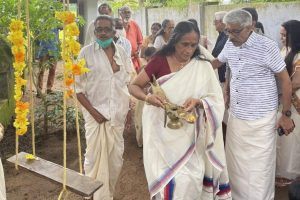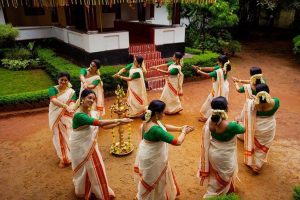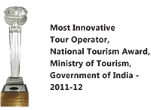Happy Onam!
The harvest festival, Onam, is an integral part of Kerala culture from time immemorial. Fond memories fill the heart of all Keralaites wherever they are anywhere across the globe. The festivities highlight the inexhaustible bounties of Nature in store for joyful co-existence and uphold the spirit of communal harmony of a society of diverse cultural background.
Dates
Onam is celebrated in the 1st month (Chingam) of the New year of Kerala’s calendar. This month coincides with the period from mid-August to mid-September. This is the time when south-west monsoon starts retreating, Sun brightens, the meandering rivers regain serenity, the breeze become balmy, the granaries are filled with fresh grain, coconut groves, banana plantations and vegetable gardens are ready for harvesting. The evergreen landscape of hills, rivers, lakes, lagoons and beaches, gets refreshed and, adorned with various blooming flowers, butterflies, dragon flies and birds, presenting a visual treat for the eyes!
History
Onam is a festival deeply rooted in tradional belief system. The festival is associated with the mythological story of an asura King- Mahaabali, who had ruled the land ideally with invincible power. However, he was quite egoistic and proud of his achievements. The legend is that the Gods who got envied by his popularity and the respect and regards he was enjoying, approached Lord Vishnu, the Supreme God, requesting to banish the King from the earth and send to the nether land. Lord Vishnu appeared before Mahaabali as a humble dwarf- Vamana, to test his ego and humility. He pleaded Mahaabali to grant 3 steps of land to live. When the hospitable and generous King agreed to offer as much space as he needs, the dwarf began to grow exponetially. By the 1st step of his foot, the whole earth was measured and with the send step the sky was measured. Seeing that no more space was left to measure the 3rd step, the King realised that the humble dwarf was none other than the Supreme, Lord Vishnu, whom he had been worshiping ardently. Enlightened to the power of Divinity, and the King humbly offered his head to measure the 3rd step.and he was sent to the nether land as wished by the Gods. However, impressed by the humility and ardent devotion of Mahaabali, Lord Vishnu had blessed him to be reborn as Indra – the God of all Gods- in the next life span, and also granted his humble wish to visit his people every year.
The spiritual interpretation of this mythological story is that even though Mahaabali was appealing to his people as an ideal ruler, he was over confident of his invincible power. The message conveyed through the story is that the egoistic mindset blinds us and leads us into troubles. Humility is the key to maintaining harmony in life.
Onam is the celebration of welcoming King-Mahaabali and people celebrate it ritualistically as per the traditional belief system.
The verses and folklore of the period describe the King as a hero who had won the heart of his people. His agrarian land was prosperous, free of diseases, decent living conditions, safe and secular, the society was well-knitted, indiscriminate and harmonious.
The translation of the oldest and the most popular song relevant to Onam and loved by all Keralites goes as:
While Maveli (Mahaabali) was ruling the land
All the people were of same status
People were living happily
Nobody had to lie or cheat
There was no insecurity for anybody
There were no diseases, death of infants
There were no poverty or crime
Only harmony and prosperity were prevailing all around.
Customs and practices
Every festival celebration is deep rooted in the traditional beliefs and also has a definite system to be followed. While practising the customs, invoking the Supreme power is of top priority. On auspicious occasions, the elderly, the differently abled and the women are given the prominence and the youngsters take blessings from them.
Onam is considered as an auspicious season for marriages, house warming or initiating new ventures. The people who work behind the scenes, artisans and performing artists are busy during the time, having plenty of opportunities to earn and celebrate Onam lavishly. The hospitals, prisons and charity organisations also celebrate Onam and entertaining programs to uplift the spirit of the inmates under their care.
The traditional Onam celebrations serve the underlying purpose of enlightening and inspiring the people to make the world harmonious through the principle of inclusiveness as followed by King Mahaabali.
Athachamayam – the ceremonial procession
Onam celebrations of all the 3 erstwhile princely states of Kerala-Travancore, Cochin and Malabar, begin with ‘Athachamayam’, a ceremonial procession from-Thripoonithura- the Royal seat of erstwhile Rajas of Kochi- to an ancient temple at the outskirts of the city.
The members of the royal family and the local people proceed to the ancient temple of Lord Vishnu, to participate in the inaugural rituals of the festival. They are accompanied by caparisoned elephants, colourful floats, tableaux and folk-art performances such as Kathakali, Mohiniyattom, percussions. This temple is considered as the venue where the King Mahaabali got enlightened to spirituality.
 The most joyful practices associated with Onam are laying of floral carpet (Pookkalam) , preparation of elaborate meal-Sadya, swinging, wearing new clothes (Onakkodi), dance, music, games and family get-togethers.
The most joyful practices associated with Onam are laying of floral carpet (Pookkalam) , preparation of elaborate meal-Sadya, swinging, wearing new clothes (Onakkodi), dance, music, games and family get-togethers.
On all the 10days’ of Onam, by early morning, after taking bath and lighting oil-lamp, the lady of the house clean the front courtyard, plaster with cow-dung, and aesthetically arrange floral design-Pookkalam- with fresh flowers, centred around of mud ball smeared with cow-dung, representing Vamana, the dwarf-the incarnation of Lord Vishnu. On the first day only the basil and Thumpa flower (leucas aspera) are used. On the second day along with Thumpa, Mukkutty flower (biophytum sensitivum) is use. From the third day onwards other flowers are also used and the number of rounds of flowers also increases. Daily the weathered flowers are replaced with fresh flowers. On the 10th day of Onam-Thiruvonam, the Pookkalam will have colourful 10 rounds of flowers and the conical mud statue smeared with rice paste and Thumpa flowers.
Since schools and colleges remain closed for 10days for Onam celebrations, children will be on the expedition to collect flowers, which helps them to explore the bio-diversity and make friends in the neighbourhood.
Traditional costume
The Onam festival season being considered as a period of prosperity, people enjoy splurging on dress, gold, furniture and kitchen utensils.
Soft handloom textile of ivory and golden yarn is used for the traditional costume for Onam. The traditional Saree-the women’s wear-is 5.5meter long or a set of 2 pieces of clothing – a mundu to wear around the waist and a Neriyathu for over the chest. Along with the traditional exquisite clothing, they also wear traditional gold jewellary. Men wear Jubba and Mundu, also of the same hand woven textile.
 Swinging
Swinging
An integral part of Onam festivities is the swing tradition. Swings adorned with flowers are slung on high branches of trees. People of all ages enjoy swinging, singing songs dedicated to the legendary King and the land.
Cultural events
 1. Kaikottikali-one
1. Kaikottikali-one
Most popular folk dance associated with Onam is Kaikottikali-one of the oldest dance forms of Kerala. It is performed by women, rhythmically moving around a lit oil lamp, clapping hands and reciting verses from epics.
 2. Boat Race
2. Boat Race
Boat races on rivers is an exciting community sport during Onam.
 Sadya – The meal
Sadya – The meal
The tradition Onam celebration concludes with exceptionally delicious and sumptuous feast- Ona Sadya. The preparations for the Sadya is as delightful as the Sadya itself. The women will be holding the fort, procuring all the ingredients, keeping the utensils ready to use and refurbishing the houses. The chips and the pickles are made in advance.
The feast is a spread to be relished using fingures. The complete meal comprising 25 to 30 dishes is a balanced mix of the 9 essential flavors. It is served on clean and fresh banana leaf to maintain the temperature of the freshly prepared food, specific quantity and order, as is recommended by Ayurveda.The tapered end of the banana leaf has to be on the left side of the person. A glass of medicated boiled will be served alongside the banana leaf. Serving of the dishes start from the left in clockwise direction: starting with salted and sweetened chips-the starters, Banana-the last to be relished along with dessert and Papad -to be relished along with the rice and dal. Then comes the pickles of Ginger-for digestion, lemon-for cleansing the taste buds, and mango pickle, to be relished along with the dishes having curd, are served. The main course is elaborate with an array of plant based lightly spicy and mildly hot dishes.
Pachady-curd and coconut-based dish of Pineapple, Thoran made of banana flower and grated coconut, Aviyal- a mix of tubers and legumes cooked in tamarind juice and flavoured with fresh coconut paste and Cumin, different preparations such as Olan and stew with different lentils, are a few of the dishes served to relish along with rice, ghee and Pappad.
The rice, dal and ghee will be served after serving the dish and the person who has to have the food must sit in front of the leaf before serving the food.
The dessert (Paayasam), is a preparation of rice pasta with molasses, coconut milk, cardamon, cashews and raisins.
A cupped palm full of Rasam -A spicy, tangy and mildly hot broth and butter milk have to be relished at the end, so as to help with the digestion. After finishing the meal the banana leaf has to be folded and disposed.
Ceremonious Rituals
The curtain comes down on Onam celebrations with ceremonious rituals at the Thrikkakara Temple, accompanied by magnificent pageantry of caparisoned elephants, resounding percussion ensembles, spectacular fireworks, power-packed cultural performances and exhilarating Boat races, which set the perfect venue for the communities to get together and rejoice.
Conclusion
For Keralites, Onam is an emotion, revitalising the bonding with Nature and the society. The rich and the poor celebrate Onam with much fervour by whatever means they have with them.
Join us on our cruise on RV Vaikundam during Onam, and experience the tradition and the heritage of Kerala!
















Leave a Reply
You must be logged in to post a comment.